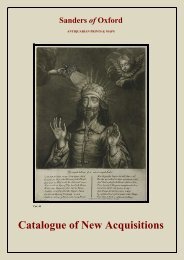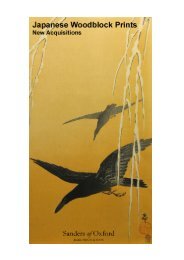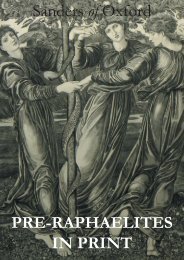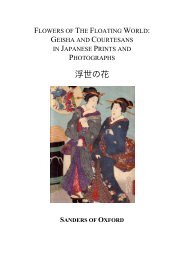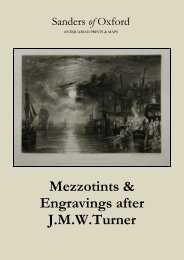catalogue text.indd - Sanders of Oxford
catalogue text.indd - Sanders of Oxford
catalogue text.indd - Sanders of Oxford
Create successful ePaper yourself
Turn your PDF publications into a flip-book with our unique Google optimized e-Paper software.
centuries. The Kirkwood family engraved banknotes and manufactured globes in addition to the production <strong>of</strong> maps<br />
and the printing <strong>of</strong> illustrations. Both William Johnston and Alexander Keith Johnston were employed by the Kirkwood<br />
family before starting their own successful firm W. & A. K. Johnston.<br />
David Lucas (1802 - 1881) was a British printmaker who specialised in mezzotint. He was a pupil <strong>of</strong> Samuel William<br />
Reynolds, and worked from Bryanston Square, London, upon the completion <strong>of</strong> his education. He produced prints<br />
after Gainsborough, Vernet, Isabey and Hoppner amongst others, but it was his works after Constable that earned him<br />
true renown. The collaboration between the pair was one <strong>of</strong> the most successful in the history <strong>of</strong> British printmaking.<br />
Whilst Turner amassed a group <strong>of</strong> faithful engravers to whom he would turn, Constable virtually employed only<br />
Lucas, and this fidelity was repaid by the stunning translation his work received from 1829, until long after his death<br />
in 1837.<br />
Samuel Palmer (1805 – 1881) was a visonary artist and contemporary <strong>of</strong> William Blake. A key figure in British Romanticism<br />
he was also a prolific writer as well as a watercolourist, etcher and printmaker. Palmer is best known for his<br />
early works executed at Shoreham where he lived between 1826 to 1835. Introduced to William Blake by John Linnel<br />
(whose daughter he would later marry) Palmer and artists George Richmond and Edward Calvert formed a group<br />
named The Ancients who were charicterised by their admiration for the work <strong>of</strong> William Blake and their attraction to<br />
archaism in art.<br />
Like many great artists, it was not until after death that the works <strong>of</strong> Samuel Palmer were rediscovered and finally afforded<br />
the attention they deserved. Although his watercolours were popular in England at the time, Palmer struggled<br />
financially throughout his life time and had to divert much <strong>of</strong> his attentions to teaching to support himself and his<br />
wife, Hannah Linnel. After his death in 1881, Samuel Palmer was largely forgotten, his surviving son, Alfred Herbert<br />
Palmer, even went as far as to burn a large portion <strong>of</strong> his fathers work in 1901, stating that: “Knowing that no one<br />
would be able to make head or tail <strong>of</strong> what I burnt; I wished to save it from a more humiliating fate”.<br />
In 1926 Martin Hardie curated a show at the Victoria and Albert Museum entitled Drawings, Etchings and Woodcuts<br />
made by Samuel Palmer and other Disciples <strong>of</strong> William Blake. This kick-started the revival <strong>of</strong> interest in Palmers<br />
work which subsequent retrospective exhibtions and publications have continuously reinforced thoughout out the rest<br />
<strong>of</strong> the 20th century. The Shoreham work in particular has had a noteable influence on several important 20th century<br />
artists such as Frederick Landseer Griggs, Robin Tanner, Graham Sutherland, Paul Drury and Eric Ravilious.<br />
Simon François Ravenet I (1706 - 1774) was a French engraver and publisher. He was born in Paris, where he studied<br />
engraving under Jacques-Philippe Le Bas. Ravenet began engraving Jean-Baptiste Massé’s ‘Grande Galerie de<br />
Versailles’ in 1731, and was still labouring on the commission when in 1743, he was brought to London by William<br />
Hogarth to work on the ‘Marriage à la Mode’ series. He then remained in Britain for the rest <strong>of</strong> his career where he<br />
made additional prints for Hogarth such as ‘The Good Samaritan,’ and the ‘Pool <strong>of</strong> Bethesda’. He was also employed<br />
by John Boydell, and engraved his ‘Collection <strong>of</strong> Prints from the most Capital Paintings in England’ between the years<br />
<strong>of</strong> 1763-72. Ravenet, together with F. Vivares, and V. M. Picot, was instrumental in the revival <strong>of</strong> engraving in England,<br />
and founded an important school for the form in London.<br />
Alfred Rethel (1816 - 1859). Rethel was a designer <strong>of</strong> woodcuts and etchings. Born in Diepenbend, 1816, he begun<br />
his studies in Aachen with Bastinés. He went on to train in Düsseldorf under Schadow (1829-36) and Frankfurt on the<br />
Main. From 1844-5 and again in 1852-3 he travelled and worked in Italy. It is believed he went insane in 1853.<br />
Archibald Robertson (1765 - 1835) was a British landscape painter and aquatinter. He is sometimes referred to as<br />
Lieutenant-General, and though he is known to have painted naval scenes, he himself never served in the forces.<br />
Robertson has also been identified with the moniker ‘Archibald Macduff’, which appears in the prints after James<br />
Barry, though this is once again tenuous, and some critics believe it to have been a pseudonym for Barry instead. What<br />
is known is that shortly after the publication <strong>of</strong> his Scottish views, Robertson emmigrated to America, wherein he<br />
opened the Columbian Academy <strong>of</strong> Painting with the help <strong>of</strong> his brother Alexander. He also made a career in painting<br />
miniature portraits upon ivory, and several <strong>of</strong> these are in the collection <strong>of</strong> the Metropolitan Museum <strong>of</strong> Art.<br />
Gérard Jean Baptiste Scotin II (1698 - 1755) was a French engraver. Scotin II began his career in Paris, and engraved<br />
several works after Antoine Watteau around the year <strong>of</strong> 1725. Together with his brother, Louis Gérard, he emmigrated<br />
to London in 1733, and remained their for the entirety <strong>of</strong> his career. During this time he produced prints after Francis<br />
Hayman for Tobias Smollett’s Edition <strong>of</strong> Cervantes ‘Don Quixote.’ He also engravinged the plates for Hogarth’s ‘Marriage-à-la-Mode’<br />
series in 1745.




